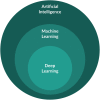Machine learning in cardiovascular magnetic resonance: basic concepts and applications
- PMID: 31590664
- PMCID: PMC6778980
- DOI: 10.1186/s12968-019-0575-y
Machine learning in cardiovascular magnetic resonance: basic concepts and applications
Abstract
Machine learning (ML) is making a dramatic impact on cardiovascular magnetic resonance (CMR) in many ways. This review seeks to highlight the major areas in CMR where ML, and deep learning in particular, can assist clinicians and engineers in improving imaging efficiency, quality, image analysis and interpretation, as well as patient evaluation. We discuss recent developments in the field of ML relevant to CMR in the areas of image acquisition & reconstruction, image analysis, diagnostic evaluation and derivation of prognostic information. To date, the main impact of ML in CMR has been to significantly reduce the time required for image segmentation and analysis. Accurate and reproducible fully automated quantification of left and right ventricular mass and volume is now available in commercial products. Active research areas include reduction of image acquisition and reconstruction time, improving spatial and temporal resolution, and analysis of perfusion and myocardial mapping. Although large cohort studies are providing valuable data sets for ML training, care must be taken in extending applications to specific patient groups. Since ML algorithms can fail in unpredictable ways, it is important to mitigate this by open source publication of computational processes and datasets. Furthermore, controlled trials are needed to evaluate methods across multiple centers and patient groups.
Keywords: Cardiovascular magnetic resonance; Deep learning; Machine learning; Radiomics.
Conflict of interest statement
Dr. Nezafat has issued and pending patents related to methods for improved cardiovascular MRI, received source code from Philips Healthcare, and receives patent royalties from Phillips Healthcare and Samsung Electronics. Drs. Leiner and disclosed institutional grants received from Pie Medical B.V.
Figures








References
Publication types
MeSH terms
Grants and funding
LinkOut - more resources
Full Text Sources
Other Literature Sources

